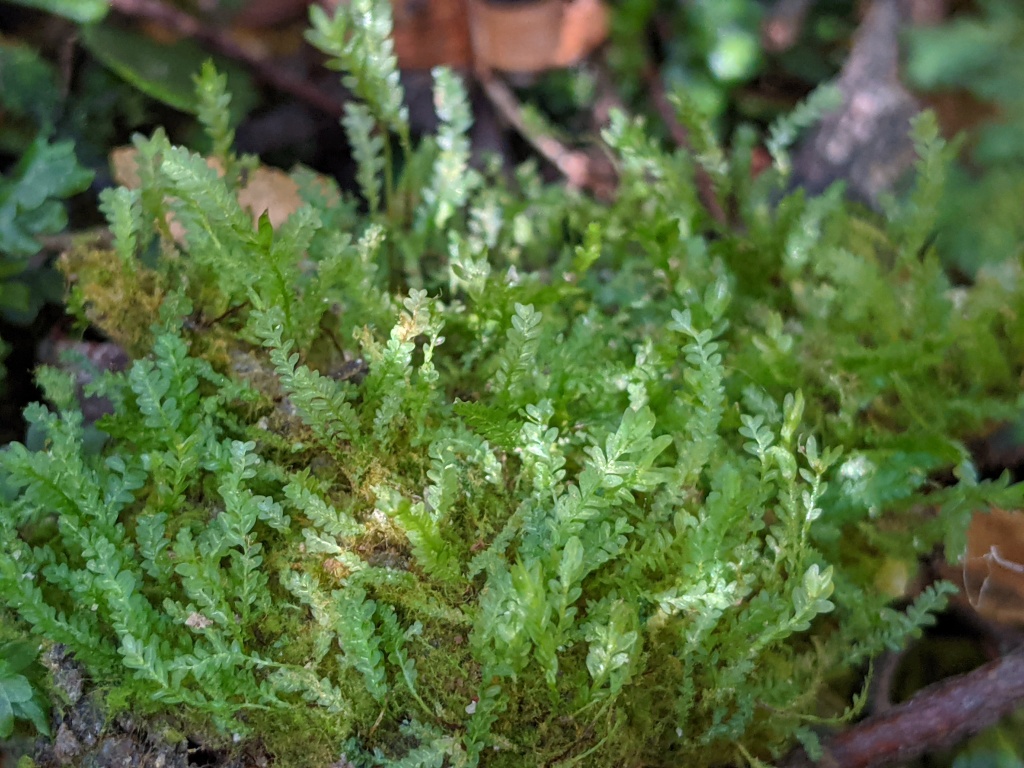Mitteniaceae
Dioicous. Protonema with two phases, either transitory with normal cylindric cells or persistent with highly refractive lenticular cells. Asexual reproduction occasionally by gemmae produced on the protonema and rhizoids. Turves or scattered shoots on soils, rarely on rocks. Stems simple or branching from basal buds, with a central strand. Leaves distichous, or spirally arranged particularly toward base and in fertile stems, monomorphic; costae subpercurrent or absent in leaves near base of stem; apices obtuse, without a hairpoint; margins entire, plane, without a border; laminal cells isodiametric, smooth; alar cells absent. Acrocarpous. Capsules exserted, operculate. Calyptra mitrate, smooth. Peristome double; exostome of 16 entire teeth, red-brown, often reflexed when moist or dry; endostome of (24–) 28–32 (–36) nodulose processes, pale yellow, forming a dome over capsule mouth.
A single genus and species in Australia, New Guinea and New Zealand.
Mitteniaceae has numerous features that make it instantly recognisable among Victorian mosses. The luminous and persistent protonema that are produced by some colonies is unique and in colonies that produce gametophytes, the obliquely orientated leaves with long decurrent leaf bases and the peristome structure are unique. The exostome of 16 long red-brown teeth are equivalent to the inner peristome of mosses with two series of peristome teeth and the single peristome in other peristomate mosses while the endostome has no equivalent structure among other mosses (Shaw 1985).
The Mitteniaceae is morphologically distinctive but has a mixture of features shared with other groups of mosses that has contributed to uncertainty in its phylogenetic position. Mitteniaceae has been placed among varying distantly related moss groups, including the Bryales (e.g. Brotherus 1924; Vitt 1982), the Schistostegales (Stone 1986), due to the close resemblance of the decurrent leaves and persistent protonema with Schistostega D.Mohr, and even the Pottiales (Goffinet et al. 2012). Shaw (1985) placed Mittenia in its own order on the basis of its unique peristome structure. Phylogenetic analysis of chloroplast rps4 DNA sequence suggested a completely different affinity to previous inferences based on morphology, placing Mittenia within the Rhizogoniaceae, most closely related to Rhizogonium (Goffinet et al. 2001). This suggests that Mittenia may be better included within the Rhizogoniaceae, but here Mitteniaceae is retained until this phylogenetic relationship can be reciprocated with additional DNA regions.
 Spinning
SpinningBrotherus, V.F. (1924). Mitteniaceae. Die Natürlichen Pflanzenfamilien 10: 422–423.
Goffinet, B.; Cox, C.J.; Shaw, A.J.; Hedderson, T.A.J. (2001). The Bryophyta (Mosses): Systematic and evolutionary inferences from an rps4 gene (cpDNA) phylogeny. Annals of Botany 87: 191–208.
Goffinet, B.; Shaw, A.J.; Buck, W.R. (2012). Classification of the Bryophyta. http://www.eeb.uconn.edu/people/goffinet/Classificationmosses.html.
Shaw, A.J. (1985). Peristome structure in the Mitteniales (ord. nov.: Musci), a neglected novelty. Systematic Botany 10: 224–233.
Stone, I.G. (1961). The highly refractive protonema of Mittenia plumula (Mitt.) Lindb. (Mitteniaceae). Proceedings of the Royal Society of Victoria 74: 119–124.
Stone, I.G. (1961). The gametophore and sporophyte of Mittenia plumula (Mitt.) Lindb.. * Australian Journal of Botany* 9: 124–150.
Stone, I.G. (1986). The relationship between Mittenia plumula (Mitt.) Lindb. and Schistostega pennata (Hedw.) Web. & Mohr.. Journal of Bryology 14: 301–314.
Stone, I.G. (2006). Mitteniaceae . Flora of Australia 15: 369–370.
Vitt, D. H. (1982). Bryopsida, in Synopsis and classification of living organisms . McGraw-Hill., New York.



